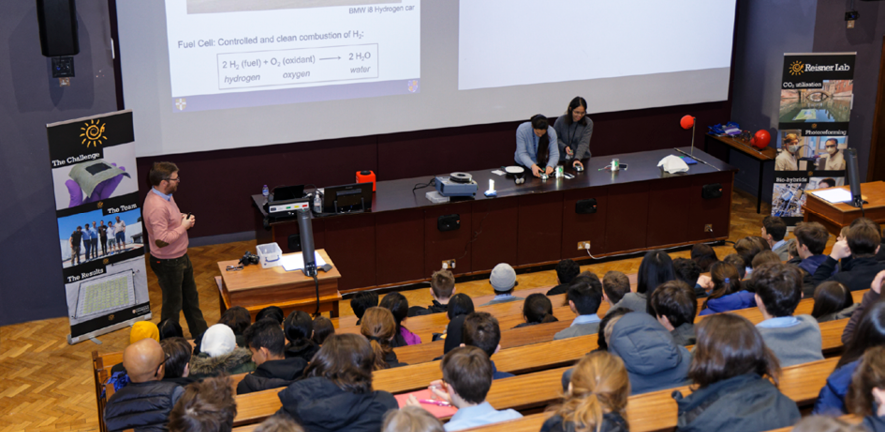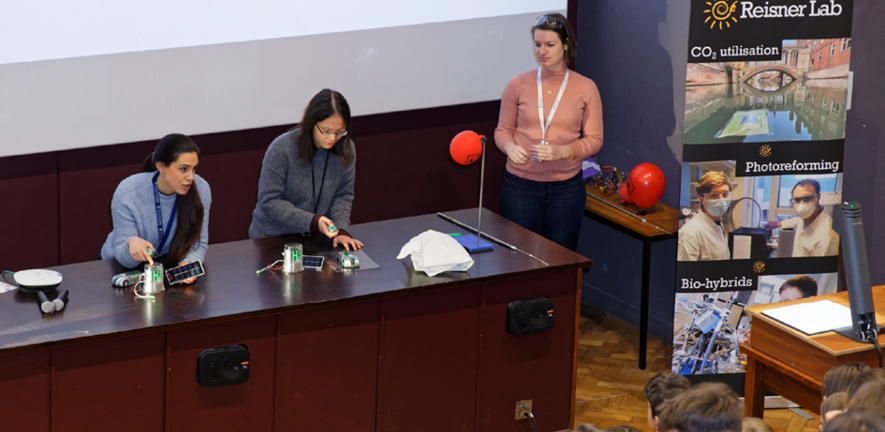
Leading this green tech is Professor of Energy and Sustainability Erwin Reisner, whose work focuses on developing new technologies that convert sunlight into sustainable energy and using solar power to upcycle waste. The group arranges outreach programmes for different audiences so that their research can inspire the public.
Upcycling plastic and CO2
Subhajit Bhattacharjee, who recently passed his PhD viva, has been working on a versatile solar-powered reactor that turns greenhouse gases and plastic into useful products. He will discuss this solar reactor and its potential role in reducing waste at our alumni festival event on 22 September.
The two compartments in the reactor work simultaneously. One chamber takes carbon dioxide and turns it into diverse fuels such as syngas or formate. The other takes waste polyethylene terephthalate (PET) plastics and produces glycolic acid, which is an important component in pharmaceutical medicines and skincare products.
Subhajit explains, “We are basically mitigating two different types of waste at the same time. Our resources are greenhouse gases like carbon dioxide and waste plastic bottles. The reactor is tunable and can produce different types of fuels from carbon dioxide depending on the integrated catalyst material”
He adds: “We get very high production rates as compared to the conventional photocatalytic processes. The best part is that the reactor doesn’t need any extra electricity or power. Just sunlight.”
Net zero-carbon fuel
Another solar-powered device from the Reisner Lab is an artificial leaf that can generate high energy density liquid fuels. The process is inspired by how natural leaves photosynthesise carbon dioxide and water into sugar and oxygen. Artificial leaves use artificial photosynthesis to mimic the function of a natural leaf, harnessing sunlight to produce multicarbon alcohols (ethanol, propanol) and oxygen from carbon dioxide and water. "This is the first ever stand-alone artificial leaf that can produce liquid multicarbon fuels directly from carbon dioxide and water using sunlight as the sole energy source," says Dr Motiar Rahaman, a senior postdoc in the Reisner Lab.
The artificial leaf has not sat idle, travelling from its maiden voyage floating down the River Cam to a competition in Ispra, Italy. It has been improved and iterated on along the way, such as reducing the number of steps it takes to go from carbon dioxide and water to fuel. Only simple products such as synthesis gas (a mixture of carbon monoxide and hydrogen) were generated using this process before, but sunlight-driven direct liquid multicarbon fuel production using an artificial leaf has now become a reality. The fuel is clean and can be used straight in a car’s engine as a drop-in fuel.
Motiar adds: “To achieve a sustainable future, you need to develop materials that enable new and improved reactions to generate renewable fuels. My message that I want to get out is ‘when thinking about energy, we should always consider renewable energy.’”
Combating climate change for high schools
In January, the outreach members of the Reisner lab, Carolina Pulignani, Celine Wing See Yeung, and Dr Tessel Bouwens and led by Erwin, invited over a hundred Year 10 students to the department for a demonstration on solar energy. The experiments were designed to inspire the students to think about different ways that solar energy can be stored in the form of fuels.

An outreach day for secondary school students.
Erwin says “One of the goals of our outreach days, especially to students about to start their GCSEs, is to get them to start thinking about important global issues and how science can help to solve them, and maybe one day they will be the ones who come up with the answers we are looking for.”
The Outreach team has also made trips to primary schools for outreach to younger students. In these settings, bursting hydrogen balloons and other experiments are a classic favourite.
“It’s an activity that never fails to draw excited screams from the audience,” says Celine, who believes it is important to communicate scientific ideas to the wider community. “Being able to communicate good science with my lab mates Carolina and Tessel makes the experience even more enjoyable,” she adds.
It is also a great venue to show off the Lego scientists of Bricktown who explain artificial photosynthesis on behalf of the lab.
The citizens of Bricktown demonstrate artificial photosynthesis. The Reisner lab.
The alumni festival
Erwin Reisner and members of the lab will be showcasing some of these incredible concepts and technologies that convert sunlight into sustainable fuels at our event for the Alumni Festival, called "Coming Full Circle" on Friday 22 September at 6pm. You can sign up using this link:
Register to attend the Alumni Festival event in-person.
Register to watch the Alumni Festival event via livestream.

